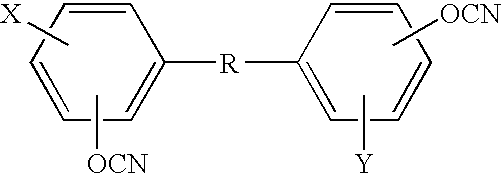Shape Memory Cyanate Ester Copolymers
- Summary
- Abstract
- Description
- Claims
- Application Information
AI Technical Summary
Benefits of technology
Problems solved by technology
Method used
Image
Examples
example 1
[0044] A 2:3 molar mixture of 4-cumylphenol cyanate ester: 1,1′ Bis(4-cyanatophenyl) ethane was combined. To the mixture was added a sufficient quantity of zinc catalyst complex suspended in nonylphenol to reach 81 parts per thousand of catalyst in the monomer. The described mixture was polymerized by heating through a cure cycle of 80° C., 100° C., 120° C., 150° C. for 2 hours each, then 177° C. for 4 hours. To prepare the shape memory polymer a mold was fabricated consisting of a 3″ by 3″ glass plate with a Viton ring encompassing the mold area. The reaction mixture formulated above was poured into the area encircled by the Viton. The mold was sealed by placing a 3″ by 3″ glass plate on top of the Viton ring. The two sheets of glass were held together by clamps around the edges. The Viton spacer also acts as a sealant in the mold. The sample was heated in an oven at 200° C. for 4 hours to obtain an SMP with Tg of 160° C. After the sample was cured for the specified period of time,...
example 2
[0046] A polymeric reaction mixture was formulated by mixing 4,4′-ethylidinediphenyl dicyanate (44.2%), 4-cumylphenol cyanate ester (40.7%) and hydroxyl terminated poly(butadiene) (15.01%) in random order to yield a pale yellow opaque solution. To aid in mixing, the resulting solution was heated at 85° C. for 4 hours with intermittent mixing to yield a clear yellow solution. To prepare the shape memory polymer a mold was fabricated consisting of a 3″ by 3″ glass plate with a Viton ring encompassing the mold area. The reaction mixture formulated above was poured into the area encircled by the Viton. The mold was sealed by placing a 3″ by 3″ glass plate on top of the Viton ring. The two sheets of glass were held together by clamps around the edges. The Viton spacer also acts as a sealant in the mold. The sample was heated at atmospheric pressure in an oven at 165° C. for 12 hours followed by a period at 220° C. for 5 hours. After the sample was cured for the specified period of time, ...
example 3
[0048] A polymeric reaction mixture was formulated by mixing 4,4′-ethylidinediphenyl dicyanate (52.1%) and 4-cumylphenol cyanate ester (47.9%) to yield a pale yellow solution. To aid in mixing, the resulting solution was heated at 85° C. for 4 hours with intermittent mixing to yield a clear yellow solution. To prepare the shape memory polymer a mold was fabricated consisting of a 3″ by 3″ glass plate with a Viton ring encompassing the mold area. The reaction mixture formulated above was poured into the area encircled by the Viton. The mold was sealed by placing a 3″ by 3″ glass plate on top of the Viton ring. The two sheets of glass were held together by clamps around the edges. The Viton spacer also acts as a sealant in the mold. The sample was heated at atmospheric pressure in an oven at 165° C. for 12 hours followed by a period at 220° C. for 5 hours. After the sample was cured for the specified period of time, it was removed from the oven and demolded by applying a slight prying...
PUM
| Property | Measurement | Unit |
|---|---|---|
| Temperature | aaaaa | aaaaa |
| Glass transition temperature | aaaaa | aaaaa |
| Glass transition temperature | aaaaa | aaaaa |
Abstract
Description
Claims
Application Information
 Login to View More
Login to View More - R&D
- Intellectual Property
- Life Sciences
- Materials
- Tech Scout
- Unparalleled Data Quality
- Higher Quality Content
- 60% Fewer Hallucinations
Browse by: Latest US Patents, China's latest patents, Technical Efficacy Thesaurus, Application Domain, Technology Topic, Popular Technical Reports.
© 2025 PatSnap. All rights reserved.Legal|Privacy policy|Modern Slavery Act Transparency Statement|Sitemap|About US| Contact US: help@patsnap.com


